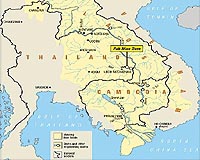 |
Sydney (AFP) Sept 29, 2009 Almost 10 percent of the world's mammals, birds, reptiles, amphibians and fish are in danger of extinction due to climate change and other factors, according to an Australian report released Tuesday. The "Number of Living Species in Australia and the World" study found 0.9 percent of the world's 1.9 million classified species were at threat, including 9.2 percent of major vertebrate species. Australia's government-funded Biological Resources Study, the world's only census of animal and plant life, found 20.8 percent of mammals were endangered, as were 12.2 percent of birds and 29.2 percent of amphibians. Of reptiles, 4.8 percent were considered threatened, along with 4.1 percent of fish species. "In Australia and around the world, biodiversity is under huge and growing pressure," said environment department secretary Robyn Kruk. "The pressures are pervasive and chronic in many places; invasive species, habitat loss and climate change in particular." Australia was found to be home to 7.8 percent of the world's known species. Environment Minister Peter Garrett said the study had shown its wildlife was highly unique, with 87 percent of mammals and 93 percent of reptiles found nowhere else in the world. However, the study also showed Australian species accounted for 9.1 percent of the world's threatened flora and fauna, and Garrett said vigilance was essential. "We have a long way to go, we have discovered and named only about a quarter of Australia's estimated number of flora and fauna," said Garrett. "We need this essential information to do a better job of managing our biodiversity against the threats of invasive species, habitat-loss and climate change." According to the report there were likely to be some 11 million species on Earth of which only 1.9 million had been discovered, with millions of invertebrates, fungi and other organisms yet to be found and named. Share This Article With Planet Earth
Related Links Darwin Today At TerraDaily.com
 New Mekong species at risk from climate change: WWF
New Mekong species at risk from climate change: WWFBangkok (AFP) Sept 25, 2009 Scientists discovered 163 new species in Southeast Asia's Greater Mekong region last year, but all are at risk of extinction due to climate change, the WWF said in a report released Friday. The newly discovered creatures include a bird-eating frog with fangs, a bird that would rather walk than fly and a gecko whose alien appearance inspired the report's title of "Close Encounters", the ... read more |
|
| The content herein, unless otherwise known to be public domain, are Copyright 1995-2009 - SpaceDaily. AFP and UPI Wire Stories are copyright Agence France-Presse and United Press International. ESA Portal Reports are copyright European Space Agency. All NASA sourced material is public domain. Additional copyrights may apply in whole or part to other bona fide parties. Advertising does not imply endorsement,agreement or approval of any opinions, statements or information provided by SpaceDaily on any Web page published or hosted by SpaceDaily. Privacy Statement |